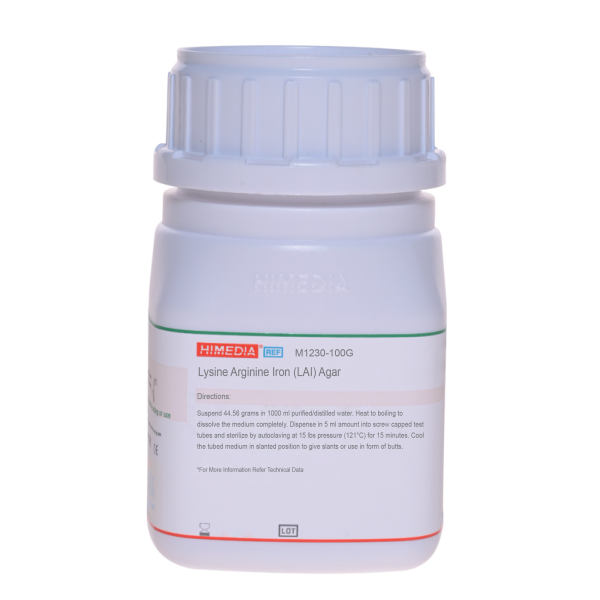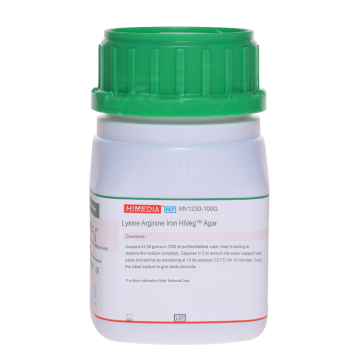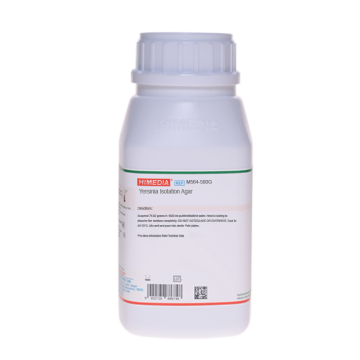 Your enquiry has been submitted
Your enquiry has been submitted
Lysine Arginine Iron (LAI) Agar
Lysine Arginine Iron Agar is used for the isolation and presumptive identification of Yersinia species from milk and milk products.
Composition
| Ingredients | Gms / Litre |
|---|---|
| Peptic digest of animal tissue | 5.000 |
| Yeast extract | 3.000 |
| L-Arginine | 10.000 |
| L-Lysine | 10.000 |
| Glucose | 1.000 |
| Ferric ammonium citrate | 0.500 |
| Sodium thiosulphate | 0.040 |
| Bromocresol purple | 0.020 |
| Agar | 15.000 |
Final pH (at 25°C): 6.8±0.2
Formula adjusted, standardized to suit performance parameters
Directions
Suspend 44.56 grams in 1000 ml distilled water. Heat to boiling to dissolve the medium completely. Dispense in 5 ml amount into screw-capped test tubes and sterilize by autoclaving at 15 lbs pressure (121°C) for 15 minutes. Cool the tubed medium to give slants and butts
Principle And Interpretation
Yersinia enterocolitica has been isolated from many kinds of clinical and non-clinical specimens and is also reported to be an increasingly significant enteric pathogen. The organism is transmitted by ingestion of contaminated food (often milk and pork) and water, probably by the fecal-oral route, and perhaps by contact with infected animals (1). Yersinia species are responsible for disease syndromes ranging from gastroenteritis to plague. Some Yersinia species have been implicated in human disease with a variety of clinical syndromes (2).
Lysine Arginine Iron Agar is formulated as recommended by APHA (3) for isolation and identification of Yersinia from milk and milk products. Lysine Arginine Iron Agar Medium is based on the ability of bacteria to decarboxylate lysine, arginine and produce H2S (4).
Peptic digest of animal tissue and yeast extract provide the necessary nitrogenous nutrients and vitamin B complex to the organisms. Ferric ammonium citrate and sodium thiosulphate are the indicators for H2S production. This medium contains two amino acids L-arginine and L-lysine. The organisms which do not decarboxylate L-lysine but ferment glucose, gives an alkaline slant and an acid butt (yellow colour, as bromocresol purple is the pH indicator).
The sample suspected to contain Yersinia can be inoculated on MacConkey Agar (M081) rather than directly streaking on Lysine Arginine Iron Agar. Inoculate the suspected Yersinia colony from MacConkey Agar (M081) on Lysine Arginine Iron Agar and incubate at 22-26°C for upto 48 hours. Organisms that give an alkaline slant, acidic butt, no gas and no hydrogen sulphide (H2S) production on Lysine Arginine Iron Agar and are urease positive, are considered to be presumptive Yersinia (3).
Quality Control
Appearance Cream to yellow homogeneous free flowing powder
Gelling Firm, comparable with 1.5% Agar gel
Colour and Clarity of prepared medium
Purple coloured, clear to slightly opalescent gel forms in tubes as slants with a butt
Reaction
Reaction of 4.45% w/v aqueous solution at 25°C. pH: 6.8±0.2
pH
6.60-7.00
Cultural Response
M1230: Cultural characteristics observed after an incubation at 25-30°C for 24-48 hours.
| Organism | Inoculum (CFU) | Growth | Slant | Butt | H2S | Gas |
|---|---|---|---|---|---|---|
| Klebsiella pneumoniae ATCC 13883 | 50-100 | luxuriant | alkaline reaction, purple colour | acidic reaction, yellow colour | negative reaction | positive reaction |
| Yersinia enterocolitica ATCC 27729 | 50-100 | luxuriant | alkaline reaction, purple colour | acidic reaction, yellow colour | negative reaction | negative reaction |
Storage and Shelf Life
Store below 30°C in tightly closed container and the prepared medium at 2-8°C. Use before expiry date on the label.
Reference
- Murray P. R., Baron J. H., Pfaller M. A., Jorgensen J. H. and Yolken R. H., (Eds.), 2003, Manual of Clinical Microbiology, 8th Ed., American Society for Microbiology, Washington, D.C.
- Wehr H. M. and Frank J. H., 2004, Standard Methods for the Microbiological Examination of Dairy Products, 17th Ed., APHA Inc., Washington, D.C.
- FDA Bacteriological Analytical Manual, 2005, 18th Ed., AOAC, Washington, D. C.
- Atlas R. M., 2004, Handbook of Microbiological Media, Lawrence C. Parks (Ed.), 3rd Edition, CRC Press.
| Product Name | Lysine Arginine Iron (LAI) Agar |
|---|---|
| SKU | M1230 |
| Product Type | Regular |
| Physical Form | Powder |
| Origin | Animal |
| Packaging type | HDPE |
| References | 1. Murray P. R., Baron J. H., Pfaller M. A., Jorgensen J. H. and Yolken R. H., (Eds.), 2003, Manual of Clinical Microbiology,8th Ed., American Society for Microbiology, Washington, D.C. |
| Customized Product Available | No |








